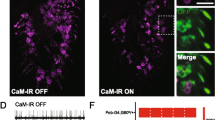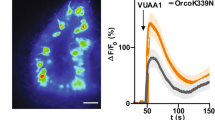Abstract
The cyclic AMP (cAMP) system plays a critical role in olfactory learning in the fruit fly,Drosophila melanogaster, as evidenced by the following: [1] The dunce gene encodes a form of cAMP phosphodiesterase (PDE). Flies carrying mutations at this gene show reduced PDE activity, high cAMP levels, and deficits in olfactory learning and memory [2]. The rutabaga gene encodes one type of adenylyl cyclase (AC) similar in properties to the Type I AC characterized from vertebrate brain. This enzyme is activated by G-protein and Ca++ and has been postulated to be a molecular coincidence detector, capable of integrating information from two independent sources such as the conditioned stimulus (CS) and the unconditioned stimulus (US) delivered to animals during Pavlovian conditioning. Rutabaga mutant flies are deficient in AC activity and show behavioral defects similar to those exhibited by dunce mutants [3]. Flies carrying mutations in the gene (DC0) that encodes the catalytic subunit of protein kinase A (PKA), the major mediator of cAMP actions, show alterations in learning performance and a loss in PKA activity.
All three genes are expressed preferentially in mushroom bodies, neuroanatomical sites that mediate olfactory learning. Interestingly, the PDE and the catalytic subunit of PKA are found primarily in axonal and dendritic compartments of the mushroom body cells, whereas the AC is found primarily in the axonal compartment. The reason for this differential compartmentalization is unclear, although the hypothetical role of AC as coincidence detector would predict that CS and US stimuli are integrated in the axonal compartment.
These observations suggest that cAMP is a dominant second messenger utilized by mushroom body cells to modulate their physiology while the animal is learning and consolidating memory. However, many other types of molecules are likely involved in the physiological alterations that occur in these cells during learning, including cell surface proteins, transcription factors, and synaptic proteins.
Similar content being viewed by others
References
Pilkis SJ, Claus TH, El-Maghrabi MR: The role of cyclic AMP in rapid and long-term regulation of gluconeogenesis and glycolysis. In: P. Greengard and G.A. Robison (eds). Advances in Second Messenger and Phosphoprotein Research. Raven Press, New York, 1988, pp 175–191
Harper JF: Second messenger-regulated exocytosis. In: P. Greengard and G.A. Robison (eds). Advances in Second Messenger and Phosphoprotein Research. Raven Press, New York, 1988, pp. 193–318
Montminy MR, Gonzalez GA, Yamamoto KK: Regulation of cAMP-inducible genes by CREB. Trends in Neurosciences 13: 184–188, 1990
Reed RR: Signaling pathways in odorant detection. Neuron 8: 205–209, 1992
Erber J, Menzel R: Localization of short-term memory in the brain of the bee, Apis mellifera. Physiol Entomol 5: 343–358, 1980
Heisenberg M, Borst A, Wagner S, Byers D:Drosophila mushroom body mutants are deficient in olfactory learning. J Neurogenet 2: 1–30, 1985
de Belle JS, Heisenberg M: Associative odor learning inDrosophila abolished by chemical ablation of mushroom bodies. Science 263: 692–695, 1994
Erber J: Response characteristics and after effects of multimodal neurons in the mushroom body area of the honey bee. Physiological Entomology 3: 77–89, 1978
Schildberger K: Multimodal interneurons in the cricket brain: properties of identified extrinsic mushroom body cells. J Comp Physiol A154: 71–79, 1984
Davis RL: Mushroom bodies andDrosophila learning. Neuron 11: 1–14, 1993
Tang WJ, Iniquez-Lluhi JA, Mumby S, Gilman AG: Regulation of mammalian adenylyl cyclases by G-protein alpha and beta gamma subunits. Cold Spring Harb Symposia on Quant Biol 57: 135–44, 1992
Bakalyar HA, Reed RR: Identification of a specialized adenylyl cyclase that may mediate odorant detection. Science 250: 1403–1406, 1990
Feinstein PG, Schrader KA, Bakalyar HA, Tang WJ, Krupinski J, Gilman AG, Reed RR: Molecular cloning and characterization of a Ca2+/calmodulin-insensitive adenylyl cyclase from rat brain. Proc Natl Acad Sci USA 88: 10173–10177, 1991
Tang W-J, Gilman AG: Type-specific regulation of adenylyl cyclase by G protein bg subunits. Science 254: 1500–1503, 1991
Krupinski J, Coussen F, Kakalyar HA, Tang W-J, Feinstein PG, Orth K, Slaughter C, Reed RR, Gilman AG: Adenylyl cyclase amino acid sequence: possible channel- or transporter-like structure. Science 244: 1558–1564, 1989
Abrams TW, Karl KA, Kandel ER: Biochemical studies of stimulus convergence during classical conditioning in Aplysia: dual regulation of adenylate cyclase by Ca2+/calmodulin and transmitter. J Neuroscience 11: 2655–2665, 1991
Levin LR, Han P-L, Hwang PM, Feinstein PG, Davis RL, Reed RR: TheDrosophila learning and memory gene rutabaga encodes a Ca2+/Calmodulin-responsive adenylyl cyclase. Cell 68: 479–489, 1992
Livingstone MS, Sziber PP, Quinn WG: Loss of calcium/calmodulin responsiveness in adenylate cyclase of rutabaga, aDrosophila learning mutant. Cell 37: 205–215, 1984
Tully T, Quinn WG: Classical conditioning and retention in normal and mutantDrosophila melanogaster. J Comp Physiol A 157: 263–277, 1985
Han P-L, Levin LR, Reed RR, Davis RL: Preferential expression of theDrosophila rutabaga gene in mushroom bodies, neural centers for learning in insects. Neuron 9: 619–627, 1992
Dudai Y: Neurogenetic dissection of learning and short-term memory inDrosophila. Annu Rev Neurosci 11: 537–563, 1988
Xia Z, Refsdal CD, Merchant KM, Dorsa DM, Storm DR: Distribution of mRNA for the calmodulin-sensitive adenylate cyclase in rat brain: expression in areas associated with learning and memory. Neuron 6: 431–443, 1991
Zhong Y, Wu CF: Altered synaptic plasticity inDrosophila memory mutants with a defective cyclic AMP cascade. Science 251: 198–201, 1991
Zhong Y, Budnik V, Wu C-F: Synaptic plasticity inDrosophila memory and hyperexcitable mutants: Role of cAMP cascade. J Neuroscience 12: 644–651, 1992
Delgado R, Hidalgo P, Diaz F, Labarca P: A cyclic AMP-activated K+ channel inDrosophila larval muscle is persistently activated in dunce. Proc Natl Acad Sci, USA 88: 557–560, 1991
Davis RL, Kauvar LM:Drosophila cyclic nucleotide phosphodiesterases. In: S.J. Strada and W.J. Thompson (eds). Advances in Cyclic Nucleotide and Protein Phosphorylation Research. Raven Press, New York, 1984 Vol 16: pp 393–402
Dauwlader B, Davis RL: Conditional rescue of the dunce learning/memory and female fertility defects withDrosophila or rat transgenes. J Neurosci. In press, 1994
Chen CN, Denome S, Davis RL: Molecular analysis of cDNA clones and the corresponding genomic coding sequences of theDrosophila dunce gene, the structural gene for cAMP phosphodiesterase. Proc Natl Acad Sci, USA 289: 9313–9317, 1986
Qiu Y, Davis RL: Genetic dissection of the learning/memory gene dunce ofDrosophila melanogaster. Genes & Development 7: 1447–1458, 1993
Davis RL, Takayasu H, Eberwine M, Myres J: Cloning and characterization of mammalian homologs of theDrosophila dunce+ gene. Proc Natl Acad Sci, USA 86: 3604–3608, 1989
Nighorn A, Healy MJ, Davis RL: The cyclic AMP phosphodiesterase encoded by theDrosophila dunce gene is concentrated in the mushroom body neuropil. Neuron 6: 455–467, 1991
Beavo JA, Reifsnyder DH: Primary sequence of cyclic nucleotide phosphodiesterase isozymes and the design of selective inhibitors. Trends Pharm Sci 11: 150–155, 1990
Horowski R, Sastre-Y-Hernandez M: Clinical effects of the neurotropic selective cAMP phosphodiesterase inhibitor rolipram in depressed patients: global evaluation of the preliminary reports. Curr Ther Res 38: 23–39, 1985
Henkel-Tigges J, Davis RL: Rat homologs of theDrosophila dunce gene code for cyclic AMP phosphodiesterases sensitive to rolipram and RO 20-1724. Mol Pharmacol 37: 7–10, 1990
Livi GP, Kmetz P, McHale MM, Cieslinske LB, Sathe GM, Taylor DP, Davis RL, Torphy TJ, Balcarek JM: Cloning and expression of cDNA for a human low-Km, rolipram-sensitive cyclic AMP phosphodiesterase. Mol Cell Biol 10: 2678–2686, 1990
Bolger G, Micheali T, Martins T. St. John T, Steiner B, Rodgers L, Riggs M, Wigler M, Ferguson K: A family of human phosphodiesterases homologous to the dunce learning and memory gene product ofDrosophila melanogaster are potential targets for antidepresssant drugs. Mol Cell Biol 13: 6558–6571, 1993
Michaeli T, Bloom TJ, Martins T, Loughney K, Ferguson K, Riggs M, Rodgers L, Beavo JA, Wigler M: Isolation and characterization of a previously undetected human cAMP phosphodiesterase by complementation of cAMP phosphodiesterase-deficient Saccharomyces cerevisiae. J Biol Chem 268: 12925–12932, 1993
Cherry J, Davis RL: A mouse homolog of dunce, a gene important for learning and memory inDrosophila, is preferentially expressed in olfactory receptor neurons. J. Neurosci, in press 1995
Swinnen JV, Joseph DR, Conti M: Molecular cloning of rat homologs ofDrosophila melanogaster dunce cAMP phosphodiesterase: evidence for a family of genes. Proc Natl Acad Sci, USA 86: 5325–5329, 1989
Knighton DR, Zheng J, Eyck LTF, Ashford VA, Nguyen-huu X, Taylor SS, Sowadski JM: Crystal structure of the catalytic subunit of cyclic adenosine monophosphate-dependent kinase. Science 253: 407–414, 1991
Taylor SS, Buechler JA, Yonemoto W: cAMP-dependent protein kinase: framework for a diverse family of regulatory enzymes. Annu Rev Biochem 59: 971–1005, 1990
Ogreid D, Doskeland SO, Gorman KB, Steinberg RA: Mutations that prevent cyclic nucleotide binding to binding sites A or B of type I cAMP-dependent protein kinase. J Biol Chem 263: 17397–404, 1988
Foster JL, Guttman JJ, Hall LM, Rosen OM:Drosophila cAMP-dependent protein kinase. J Biol Chem 259: 13049–13055, 1984
Kalderon D, Rubin GM: Isolation and characterization ofDrosophila cAMP-dependent protein kinase genes. Genes Dev. 2: 1539–1556, 1988
Foster JL, Higgins GC, Jackson FR. Cloning, sequence, and expression of theDrosophila cAMP-dependent protein kinase catalytic subunit gene. J Biol Chem 263: 1676–1681, 1988
Melendez, Kalderon D:Drosophila Research Conference pg 255
Muller U, Spatz H: Ca2+-dependent proteolytic modification of the cAMP-dependent protein kinase inDrosophila wild-type and dunce memory mutants. J Neurogenetics 6: 95–114, 1989
Lane ME, Kalderon D: Genetic investigation of cAMP-dependent protein kinase function inDrosophila development. Genes Dev 7: 1229–1243, 1993
Skoulakis EMC, Kalderon D, Davis RL: Preferential expression in mushroom bodies of the catalytic subunit of protein kinase A and its role in learning and memory. Neuron 11: 197–208, 1993
Drain P, Folkers E, Quinn WG: cAMP-dependent protein kinase and the disruption of learning in transgenic flies. Neuron 6: 71–82, 1991
Cadd G, McKnight GS: Distinct patterns of cAMP-dependent protein kinase gene expression in mouse brain. Neuron 3: 71–79, 1989
Lancet D: Vertebrate olfactory reception. Ann Rev Neurosci 9: 329–355, 1986
Buck L, Axel R: A novel mutligene family may encode odorant receptors: a molecular basis for odor recognition. Cell 64: 175–187, 1991
Jones DT, Reed RR: Golf: An olfactory neuron specific-G protein involved in odorant signal transduction. Science 244: 790–795, 1989
Dhallan RS, Yau K-W, Schrader KA, Reed RR: Primary structure and functional expression of a cyclic nucleotide-activated channel from olfactory neurons. Nature 347: 184–187, 1990
Author information
Authors and Affiliations
Rights and permissions
About this article
Cite this article
Davis, R.L., Cherry, J., Dauwalder, B. et al. The cyclic AMP system andDrosophila learning. Mol Cell Biochem 149, 271–278 (1995). https://doi.org/10.1007/BF01076588
Issue Date:
DOI: https://doi.org/10.1007/BF01076588




